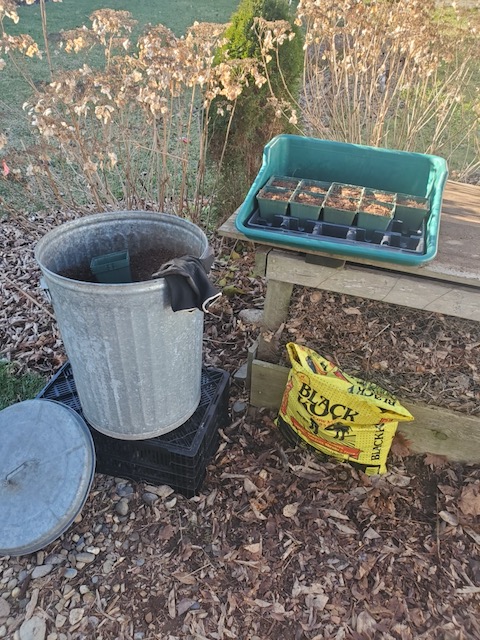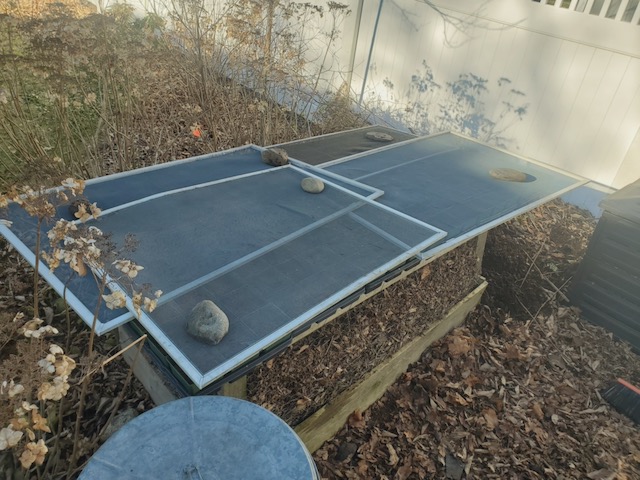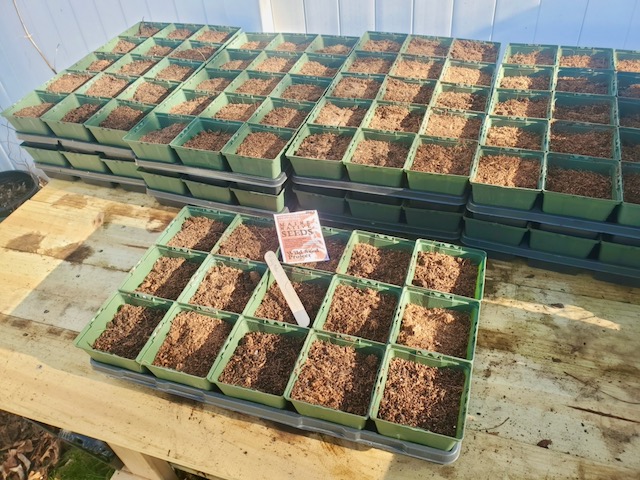Above: George’s pots are ready for native seeds.
Many native seeds need cold weather so they can more easily split open in the spring
By George Christie
Because the vast majority of our garden seeds have been under cultivation for hundreds, if not thousands, of years, they typically sprout within a few days of planting. This works fine for us because it means so long as we keep them dry and safe from pests, we can plant them whenever we think the time is right. But such is not the case for most New England native seeds, so as Christmas Day warmed up under a sunny sky, I realized it was the perfect day to get some native seeds into pots so they could winter stratify in their own good time and spring to life in April.
In general the New England native perennials, grasses, and shrubs and trees I prefer to grow for my garden and to share with others have evolved in areas where winter temperatures will kill newly germinated seeds. So, once ripe in summer or fall, they have a strong tendency to go dormant, and wait for warm days in the next year before they sprout.
Nature is tough, however, and wanting is not without its threats. Just as humans have found rice, wheat, corn, and other seeds to be great food so have many other organisms, from fungi and bacteria to chickadees and deer. One strategy seeds have evolved to protect their stored energy of the seed is to toughen up the shell around—there’s a reason bags of Brazil nuts aren’t sold at ball games and art festivals!
Which is where the concept of cold stratifying native seeds comes into play and why I was happy to have such a delightful day for planting. It turns out many native seeds need the cold weather to affect the seed so that it can more easily split open in the spring. Whether it’s mechanical damage done to the outer surface of the seed or simply the effect of freezing and thawing, native seeds germinate better when placed in moist soil and allowed to over-winter outside.
There are many ways to do this. I often see people cut milk jugs in half, plant the seeds then put the upper half back on, creating a mini greenhouse while protecting the plants from squirrels and chipmunks. I keep it simple. I plant the seeds just like I always do, though I usually don’t even bother to bury them, then cover the trays with old window screens I saved from when we had our windows replaced. I leave them outside, exposed to the elements, and wait. The screens allow rain to enter but tend to break up large rain drops so the soil isn’t badly disturbed. Like I said, simple.
I should point out I used recycled pots—Wildwood Nursery has a recycling bin for pots in the parking lot and one can take as well as give. I’ve also been practicing with various soils. This year I’m using a mix of Black Cow manure and coir, ground up coconut husks. The coir is a byproduct of the coconut industry and replaces peat moss which is functionally a non-renewable product. I tried it last spring (there are some native plants that can be planted in the spring) and it worked out well. As far as amounts, I mix until it feels “right.” I’m sure there’s more variation that a commercial grower would ever tolerate, but I’ve worked with a lot of potting and seed-starting, so am happy with the “mix until I like it” approach.

George uses a mix of Black Cow manure and coir (ground up coconut husks).
Some of you might be asking, hey, if they go dormant for the winter, why not just plant them on a warm day in October? Truthfully, that’s what I used to do. But, here’s the catch. Nature isn’t perfect and not every species needs a full winter. In fact, many will start to grow after as little as thirty days of cold weather. So as our winters warm, I can’t reliably count on it staying cold enough long enough to keep the seeds from sprouting. Several years ago, I saw both sundial lupine and blue false indigo sprout in late November and early December. Of course, they died as soon as the next real frost hit them. By waiting until now, I lower the chances that a random warm spell will cause some seeds to germinate.
So given a beautiful day during the optimal time to plant these seeds, you can see why, as my wife took a book to enjoy our deck on Christmas day, I grabbed my box of seeds, planted up thirteen trays and tucked them under screens and then joined her in the sun.

Native seeds ready for winter. George uses old window screens to allow rain in and keep critters out.
George Christie studied entomology and landscape architecture and has worked in mosquito control, environmental education and garden design and plant sales. He currently works for the Rhode Island Natural History Survey managing their rare species database.






 Subscribe
Subscribe
I love your columns and your hints for success with plants and seeds. Thank you.
Thank you!